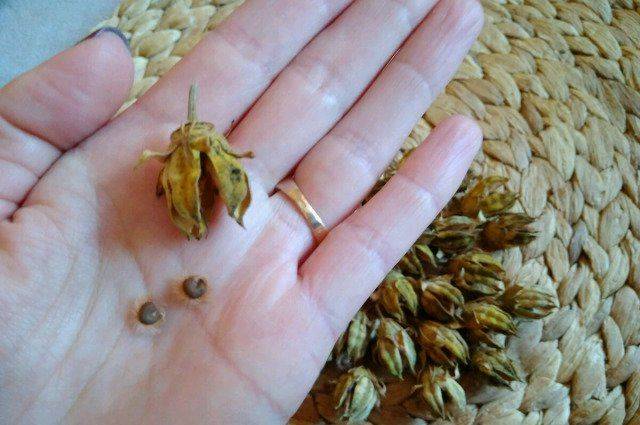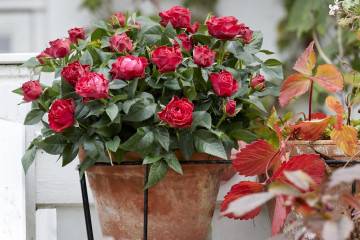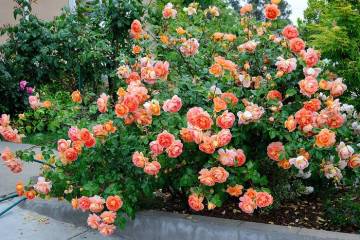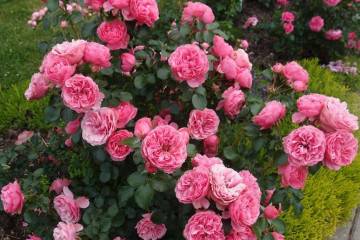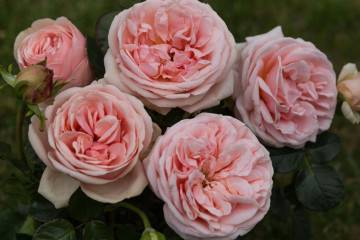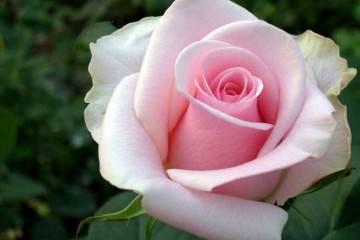Chinese indoor rose (hibiscus) - varieties, care and reproduction
Content:
- What does a Chinese indoor rose or hibiscus look like, which family does it belong to?
- Features of caring for hibiscus at home
- Features of winter care, the dormant period of the Chinese rose
- When and how it blooms
- How to trim properly
- How the Chinese rose reproduces
- Transfer
- Possible problems in growing a rose tree
- Signs and superstitions
The Chinese indoor rose (hibiscus) is one of the most popular tree-like plants. Growing up to 2 m in height and possessing a lush crown of juicy green leaves, hibiscus will adorn any interior. They love him for the unpretentiousness and beauty of large buds.
What does a Chinese indoor rose or hibiscus look like, which family does it belong to?
The rose belongs to the Malvovye family. Description:
- The trunk is straight. Height - up to 2 m, bark is light, with a grayish-brown tint.
- The leaf plates are green, with a glossy surface, serrated at the edges.
- The buds are exotic due to the fact that the stamens and pistil are longer than the petals, the shape is cup-shaped, the diameter is from 8 to 14 cm, the color depends on the variety of the bush.
Common species and varieties
The species has more than 300 subspecies of the Chinese rose. But only a few of them can be grown as a house bush:
- Mix - reaches a height of 70 to 120 cm. Inflorescences are large, colored in any shades, from white to red.
- King - terry inflorescences, up to 17 cm in diameter. It is difficult to care for the variety, it often sheds unopened buds, and requires schematic pruning.
- Cooper - a distinctive feature of this rose - its leaf plates, in the color of which several shades are combined, red, green and white.
A variety of other subspecies can be grown in the open area, in the garden or in summer cottages.
Beneficial features
Chinese rose has healing properties:
- Substances in the composition of leaf plates and petals have a bactericidal effect.
- Antacids normalize blood pressure, strengthen the walls of blood vessels.
- Flavonoids improve and accelerate metabolic processes, stimulate the production of bile.
The well-known rose drink - hibiscus, refreshes in the heat, tones, has a diuretic and choleretic effect, relieves spasms.
Briefly about the history of appearance
The homeland of the plant is the southern regions of China and the north of Indochina. It also grows on the islands of the Pacific coast. In Russia, given the rather cold climate, it is grown in residential buildings and greenhouses, but not as a street bush.
Features of caring for hibiscus at home
Home care for a Chinese room rose is not difficult.
Temperature and lighting
In summer, the optimum temperature is 18-20 ° C, in winter about 15 ° C, but not lower.
The tree loves strong, diffused lighting or partial shade. Does not tolerate direct sunlight.
Watering
Abundant watering is carried out as the top layer of the earth dries up to 20 cm. Purified or settled water at room temperature is used.
Spraying
Humidity should be high, 60% or more.Therefore, in a hot period or when the air in the room is dry, it is necessary to spray the crown daily. If the leaf plates are covered with dust, the rose can be placed under a warm shower, having previously covered the soil with a film.
Priming
Rose soil needs nutritious, enriched with mineral elements. The soil should be light and loose, allowing water and air to flow to the roots. The pH level is neutral, about 6.
The soil can be made independently by mixing the following ingredients in equal parts:
- humus earth;
- sand;
- leafy land;
- sod land.
Without fail, drainage from expanded clay or small stones is placed on the bottom of the pot.
Top dressing
Rose really likes fertilizers, she reacts to them with active growth and the appearance of numerous, large buds. Top dressing is applied only in summer or spring. Fertilizers are not used in winter. Top dressing is introduced 2 times a month.
For a rose, you need to choose complex mineral fertilizers, which include phosphorus, potassium and nitrogen.
Features of winter care, the dormant period of the Chinese rose
In winter, once every 2 days, the crown must be sprayed with cool water. If the air is too dry, the procedure is carried out every day. Fertilizers are not used, no trimming is carried out.
When and how it blooms
When favorable conditions are created, the rose blooms in early May and pleases with buds until late autumn. In general, the duration depends on the growing conditions.
Flower types - double or simple. Rose buds are narrow, as the petals open, they acquire a cup-shaped shape.
How to trim properly
Pruning rules and features:
- The procedure is carried out in early spring, before the rose begins to bloom.
- Weak and damaged shoots, bare or dried branches are subject to removal.
- Shoots that are not completely trimmed are shortened by 1/2 of their length.
- Sections are processed with garden pitch so that juice does not flow out of the shoots.
- To rejuvenate and refresh the rose, you need to cut all branches by 15 cm.
How the Chinese rose reproduces
Rose tree indoor propagation is carried out by cuttings, seeds and air layers.
Germinating seeds
To propagate a rose, the seed can be harvested by yourself. The seeds are in the bell of the inflorescence. The sowing period is from January to March.
Growing process:
- The seeds are dipped in a growth stimulator for 12 hours.
- The grains are laid out in a piece of cloth soaked in water, additionally wrapped in cellophane on top.
- At the first appearance of seedlings from seeds, they are transferred to the nutrient soil. The container with the planting material is covered with a film and kept at a temperature of 25 ° C to 27 ° C.
- Moistening is carried out as the top layer of the soil dries up; daily the film is removed to ventilate the earth.
When 2-3 leaf plates appear on the sprouts, the seedlings are planted in separate flowerpots.
Rooting cuttings
Cuttings can be taken when pruning. For cuttings, branches that are 3 years old or more are suitable. The cut off stalk is placed in water or nutrient soil.If planting is carried out in the ground, only 2 upper leaf plates are left on the branch, the cutting is covered with a plastic bottle.
The root system will begin to appear in about 30 days. The first appearance of the buds can be expected in 1-1.5 years.
Air layering
A rose can multiply with simple layering. A suitable branch is chosen, which, without separating it from the mother bush, is bent to the ground and covered with earth. The escape must be secured with a bracket.
Caring for the shoot is the same as for a rose: regular hydration, fertilization. The roots will form in a month, after which the shoot is separated and transplanted into a separate container.
Transfer
A young bush is transplanted every 1-2 years. It is better not to touch old roses. Nutrient soil is being prepared for transplantation:
- 4 pieces of turf;
- 1 part sand;
- 3 parts deciduous humus;
- 1 part humus.
Drainage is poured into a new flowerpot at the bottom, prepared earth on top. The transplant is carried out by the transshipment method - a lump of old earth must be preserved on the roots.
Possible problems in growing a rose tree
A rose in the house is an unpretentious tree and rather resistant to diseases. Their appearance is the result of improper care.
The most common problems:
- Sheds buds and leaves - temperatures are too low, not higher than +10 ° C.
- The leaves turn yellow. This happens due to the abundant moisture in the soil. If the color changes in most of the crown, only a transplant can save the bush.
- The rose dries up. The reason is the frequent drying out of the soil.
- The foliage falls off. The reason is the lack of sunlight.
Another common problem is the plant won't flower. The reasons why the bush cannot bloom:
- high indoor temperatures in winter;
- insufficient lighting during the growing season.
You can correct the situation by taking care of the rose.
Pests
The bush can infect aphids or spider mites. Treatment - treatment of the rose with soapy water. In a neglected situation, insecticides are used.
Hibiscus withers
The reasons are lack of moisture or transplanting an old bush, poor condition of the root system. The bush is transplanted, the roots are carefully checked, bad and weak roots are removed.
Signs and superstitions
Some consider a rose a harbinger of death, others gladly plant this beautiful and lush bush in their home.
The tree is shrouded in a number of beliefs:
- a rose in the family - to constant quarrels;
- flowering sooner or later - to big trouble;
- falling leaves - a disease of a loved one;
- the bush blooms profusely in the girl's room - an early meeting with the groom.
Chinese rose is an amazingly beautiful tree-like bush with a lush crown and numerous buds. All the signs associated with a flower are nothing more than prejudices. The behavior and condition of the rose is associated exclusively with the correct care for it.



